
Product test
Samsung Odyssey OLED G8 tested: good picture, bloated software
by Samuel Buchmann

Do you want a clear picture in fast-paced shooters, even when in motion? Then you should take a look at Samsung's 27-inch screen. However, focussing on the frame rate means that you have to compromise on other things.
360 frames per second: Samsung's new monitor is one of the first OLEDs with an extremely high frame rate. It should ensure particularly clear images in motion. This is particularly important in competitive shooters.
The Odyssey OLED G6 is the little brother of the Odyssey OLED G8, which I recently tested. It is smaller in comparison, but cheaper. And it has a lower resolution, but more hertz. The QD OLED panel comes from Samsung's own display division.
The specifications at a glance:
Note: I received a pre-production model from Samsung for this test. The final product could still improve things - especially with the firmware. I will point this out in the appropriate places.
Samsung's design is the same for all OLED models: a metal plate as a stand, lots of silver plastic everywhere else. In the price range under 1000 francs, I think that's fine. Visually, the monitor looks slim and simple. The RGB light ring on the back is the only indication that this is a gaming product. It can also be switched off.
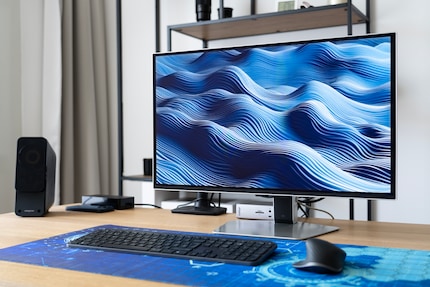
The stability of the stand should be better. Fortunately, this is not as noticeable on the 27-inch model as on its big brother. The connections are standard fare: two HDMI 2.1 and one DisplayPort 1.4. There is also the obligatory hub with two USB-A sockets. In contrast to the Odyssey OLED G8, Samsung has at least installed a jack plug here. This means I can loop the sound to my speakers via the monitor using HDMI. The screen does not have its own speakers.
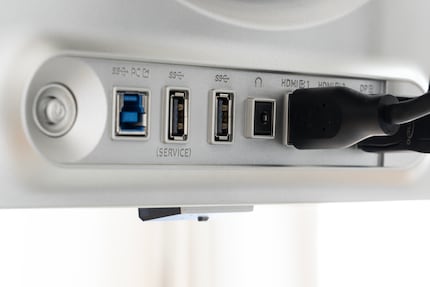
Only two things annoy me: Firstly, the external power supply - I would prefer a slightly thicker screen to a brick on or under the table. Secondly, my copy of the Odyssey OLED G6 suffers from pronounced coil whine. Depending on the picture content, the thing sometimes beeps more, sometimes less. The noise is a nuisance in a quiet environment.
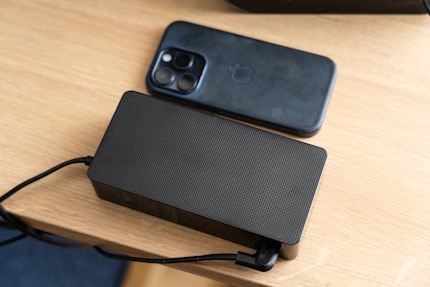
What follows now goes deep into the subject matter. The measurements with professional tools from Portrait Display allow an objective categorisation of the image quality. If you are not interested in the details and diagrams, you can read the short version and then scroll to the "Gaming" chapter.
The most important findings in brief:
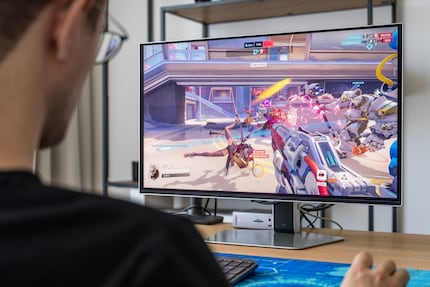
The Odyssey OLED G6 achieves a brightness of 255 nits in SDR mode. If the sun is shining directly into my room, I would like more, but in all other situations it is enough. There is no option for dynamic SDR brightness like on its big brother. This means that white is always the same brightness, no matter how large its share of the overall picture is.
I like this when I'm working or surfing the net. I don't want constantly fluctuating brightness here. When gaming, a dynamic maximum during the day is an advantage. Because the relatively low brightness is still the biggest disadvantage of OLED screens.
The panel of my test model is evenly illuminated. I measured a maximum DeltaE of 0.7 between the centre and edges of the screen.
The maximum HDR brightness is slightly higher than that of the Odyssey OLED G8: I measured 999 nits when I set the "Peak Brightness" to "High". As the test window gets larger, the brightness drops rapidly - as with all QD OLED panels. LG's WOLED panels are ahead in this respect. In the following graphic, these are represented by the Asus PG34WCDM.
In bright surroundings, WOLED monitors are also superior in terms of black level: Black appears somewhat washed out and purple in bright surroundings due to the lack of a polarisation filter. The matt surface of the Odyssey OLED G6 exacerbates this problem. It does conceal point sources of light. However, this does not eliminate the reflections, but only diffuses them. The bottom line is that a glossy display looks crisper and sharper.
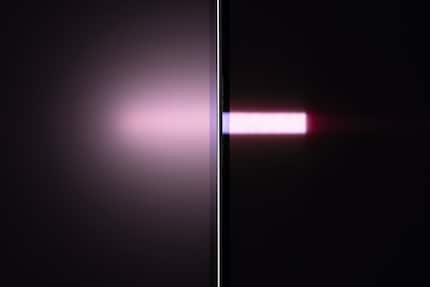
The measurements for colours and shades of grey are intended to answer three questions:
My test model of the Odyssey OLED G6 comes from the factory with the "Graphics" picture setting - that's a good thing! It is by far the best calibrated. Gamma and white balance are very close to the target values. Light grey tones have a slight green tint. However, the maximum DeltaE of 3.6 is still perfectly acceptable.
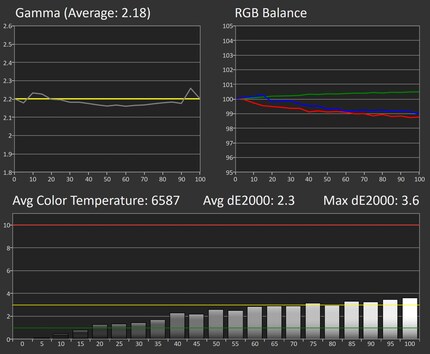
The Odyssey OLED G8 covers the common SDR colour spaces very well:
Since the latest OLED generation, I have become accustomed to the high AdobeRGB coverage. The colour accuracy is also very good (average DeltaE of 2.3). Until recently, specialised monitors were needed to achieve such colour fidelity.
The only problem with wide-gamut panels such as the Odyssey OLED G6 is that the colours of sRGB content are too saturated (average DeltaE of 4.2). However, this is due to Windows' poor colour management. MacOS displays various colour spaces correctly system-wide.
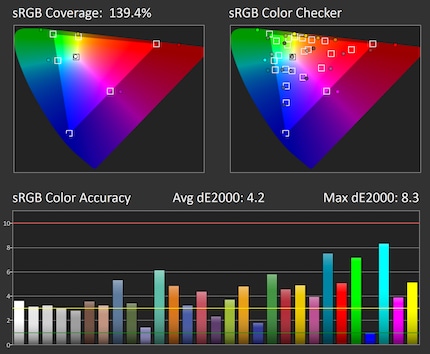
Samsung does not offer an extra picture mode for sRGB content on the Odyssey OLED G6. I can switch between the "Native" and "Normal" colour spaces. But that doesn't seem to do anything. Perhaps this is due to the non-finalised firmware. Either way, it hardly matters for a gaming monitor.
The Odyssey OLED G6 continues its good performance with HDR content. It also offers good accuracy here. Shadows are slightly lifted. WOLED monitors offer the more impressive experience in most scenes. This is because their brightness does not drop as quickly when the image has a greater proportion of white (more precisely, a higher Average Picture Level, APL).
I measure the coverage of the HDR colour spaces:
The coverage of the large BT.2020 colour space is even slightly higher than that of the Odyssey OLED G8. In practice, this hardly matters. Most content today is matched to DCI-P3. The Odyssey OLED G6 covers this colour space almost completely. The colour accuracy is also excellent with an average DeltaE of 1.8.
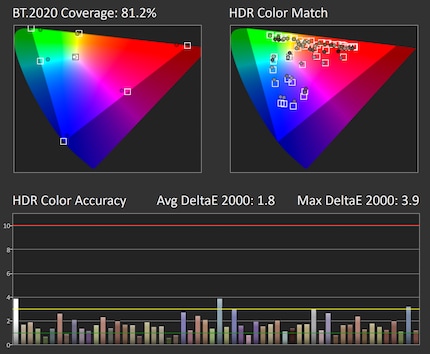
The Odyssey OLED G6 supports the HDR standard HDR10. As with its TVs, Samsung has dispensed with DolbyVision in favour of its own HDR10+ standard.
The headline of the Samsung Odyssey OLED G6 is its high frame rate: 360 Hertz. What does that actually do? Theoretically three things:
Theoretically. In practice, I feel and see no difference between 240 and 360 hertz in the first two points. However, I have to say that my shooter skills are terrible. I'm sure that professionals benefit from the extremely short input lag. And according to a new study, not all people are equally sensitive when it comes to perceiving high frame rates.
I can only see the improved clarity of moving objects - if I pay explicit attention to them. For example, the test UFO appears sharper than at 240 hertz when I follow it with my eyes.
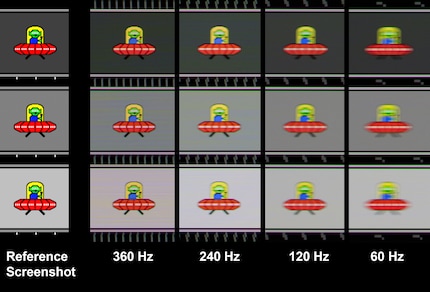
Is it worth buying a 360 hertz OLED for this reason? In my opinion: only in exceptional cases. If you don't exclusively play fast first-person shooters, you'll hardly notice the advantage of the high frame rate. Then you're better off with one of the new 4K OLEDs. These do cost a little more. But the larger screen area and higher resolution are definitely worth the extra cost. They make a bigger difference than the 120 additional hertz of the Odyssey OLED G6.
Just like its big brother, the new 27-incher also needs a lot of power: your PC has to be able to calculate 360 FPS in 1440p. In games like Overwatch or Halo Infinite, my system with AMD Radeon 7900 XTX manages this without any problems. However, upscaling technologies are required for such frame rates in graphics-intensive games.
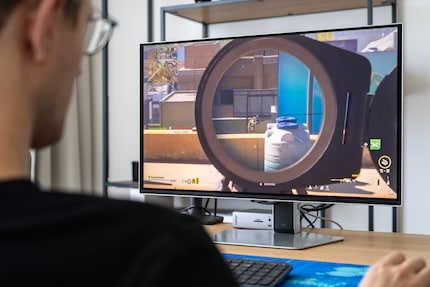
There are better monitors for working than the Odyssey OLED G6. No wonder, after all, that's not what it's primarily designed for. The pixel density of 108 pixels per inch (ppi) is only average. At least the subpixel pattern of the new QD OLED generation reduces the dreaded colour fringing. Text appears sufficiently sharp.
After a few minutes of inactivity, the screen dims down to protect itself from burn-in. However, this only happens with completely static image content. Just moving the mouse is enough for it to return to normal brightness.
I find the second preventative measure against uneven wear and tear more annoying: Pixel Shift. The monitor shifts the image slightly every minute. It feels much more frequent and stronger than with other devices. The function cannot be deactivated. After noticing it once, I notice it all the time.
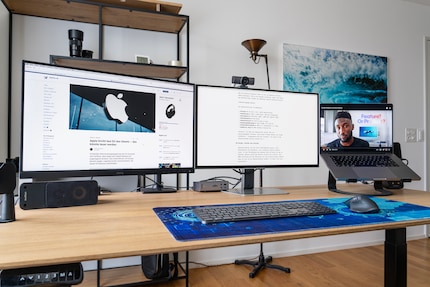
As with all OLED monitors, the burn-in risk remains an unpredictable factor. The hotter the panel gets, the more likely the individual pixels are to wear unevenly. Fortunately, the larger Odyssey OLED G8 effectively dissipated the heat when tested. Without a comparison device, I can't verify this with its smaller brother. However, due to the identical design, I assume that it has a similar cooling system.
Samsung offers a three-year burn-in guarantee on its QD OLED monitors. Annoyingly, this information cannot be found on an official website. But Samsung Switzerland has confirmed this to me several times: If you have burn-in problems, the panel will be replaced.
While Samsung uses Tizen OS for larger models, the South Koreans have dispensed with the smart TV operating system for the Odyssey OLED G6. Fortunately. At no point do I miss the additional functions.
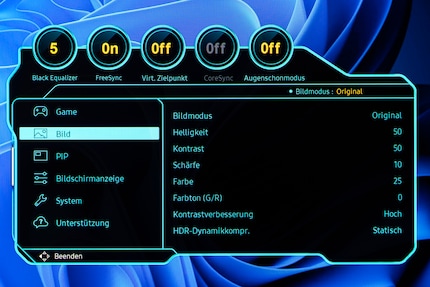
The reduced menu of the 27-inch device is much clearer. I can quickly access the settings that I really need: brightness, input signal selection, volume of the connected speakers. Operation is via a small joystick at the bottom on the back.
The Samsung Odyssey OLED G6 is a good gaming monitor in its size class. Apart from the resolution, it offers the same picture quality as other current OLEDs. This means: great black levels, great colours, satisfactory brightness. The factory calibration is very good in both SDR and HDR mode.
However, the party trick of the Odyssey OLED G6 is its high frame rate in combination with the short response time of the OLED pixels. Together, they reduce the blurring of moving objects to a minimum. This is particularly noticeable in shooters: Even during fast camera pans, opponents remain crystal clear. As a casual gamer, I hardly benefit from this. For professionals, this advantage can perhaps be decisive.
I wouldn't recommend the Odyssey OLED G6 to anyone else. If you play a wide range of games, you're better off with one of the 32-inch 4K OLEDs with 240 hertz. Depending on the model, they are only slightly more expensive - such as the Alienware AW3225QF. I find the depth of detail and the larger screen area more valuable than an even higher frame rate.
If you actually belong to the target group of professional e-athletes, it might also be worth being patient: The Asus PG27AQDP will be released in the second half of 2024. Its WOLED panel from LG has the same resolution, but even 480 hertz. However, this would give you even fewer excuses if the headshot isn't right.
Pro
Contra
My fingerprint often changes so drastically that my MacBook doesn't recognise it anymore. The reason? If I'm not clinging to a monitor or camera, I'm probably clinging to a rockface by the tips of my fingers.